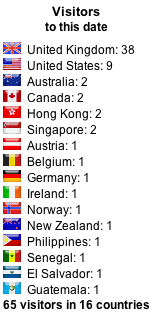Friday, May 12, 2006
Thursday, May 11, 2006
You choose: what should I post next?
You may vote in the sidebar, under "Archives".
(Sorry, you may have to reload this page to view the poll.)
A preview of each post:
1. Story of the day

2. Eclipses
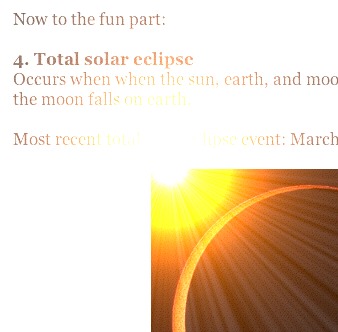
3. Hong Kong case studies

Poll ends (and posting starts!) either when the number of votes for the first choice is more than 25% than that for the second or when there are 10 votes.
In the meantime, Question of the day:
Thomas is in his rowboat, about to lower a solid bronze mermaid into his pool. Once this sculpture is placed on her throne successfully, will the water in the pool have risen, fallen, or stayed the same level as shown below?
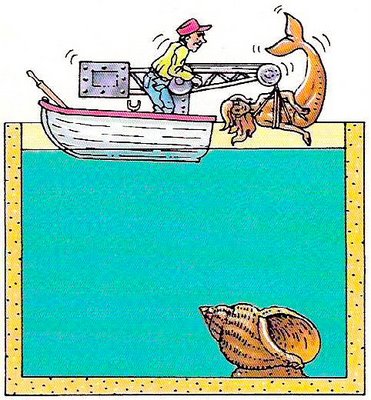
Bonus: Will the water level rise, fall, or stay the same when the mermaid is fully submerged but has not yet touched the bottom?
Wednesday, May 10, 2006
Cartograms: Density-equalising maps
We've all seen this map before:
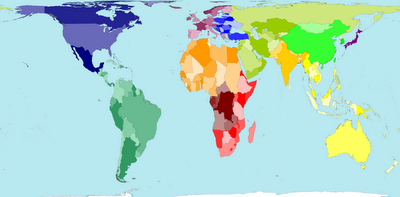
It's the famous Peters projection - the Area map. Okay let's give it credit for giving us a general idea of the spatial structure of the land mass on Earth, but the maps below will blow your mind.
1. Upside down
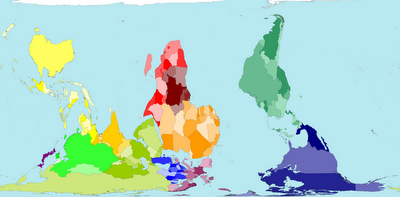
This is easy to obtain - I've done this myself - just rotate the original map by 180º. But it does change the way you view the world.
You may say boring... now what? How about using an algorithm now, to blow up the map according to:
2. Total children

3. Total elderly
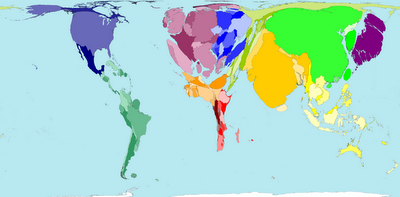
4. Tourist destinations
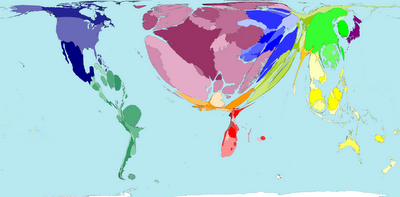
5. Tourist origins
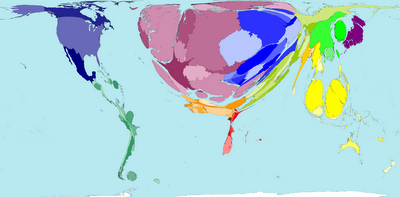
These are density-equalising maps, known as cartograms. Once you've got the data, say from World Bank, you can use an algorithm (once used for linear diffusion from elementary physics*) to allow 'population to flow out from high-density to low-density areas'.
As promised, a bit of history now. But using cartograms to make this more entertaining.
Blown-up maps of population in:
6. Year 1
"The population two thousand years ago is estimated to have been 231 million. At this time North and South America were sparsely populated, as was Asia Pacific. The estimated population of New Zealand was zero. Southern Asia, Northern Africa, China and Southern Europe (parts of the same land mass) had relatively high populations. Colder Northern latitudes tended to have lower populations.
The territories that now encompass the Ganges, Tigris, Yangtze, Nile and Po rivers were the most populous."
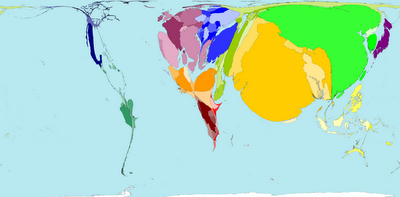
7. Year 1500
"At the time of Spanish conquest in South America, and when Christopher Columbus was exploring Central and South America, the combined population of Mexico and Peru was greater than the total of all other American countries.
The regions with the largest populations remained Southern Asia and Eastern Asia. Together these contained more than half of the world's population.
Worldwide population distribution in 1500 was roughly similar to that in year 1, despite the numbers almost doubling over this period."
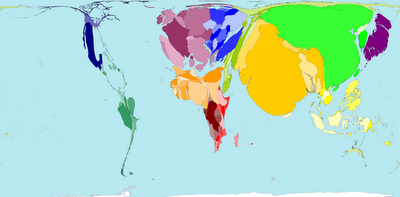
8. Year 1900
"The world population tripled between 1500 and 1900, to an estimated 1564 million. In that period, the populations of the United Kingdom and the United States increased more than ten-fold, the population of the Netherlands increased five-fold. For most of this time the Netherlands were known as the United Provinces; whilst neither the United Kingdom, nor the United States, had been formed.
In 1900 much of the world was under imperial rule, new territorial boundaries were being defined and contested. The borders of Africa shown in this map were mostly drawn at the Treaty of Versaille, in 1919."
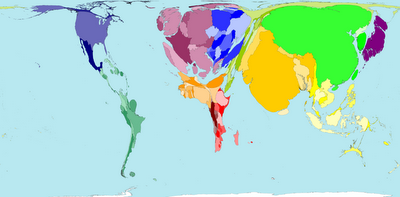
9. Year 1960
"The world population in 1960 was 3,039 million. As is the case today, the populations of China and India are (independently) more than twice as big as that of the next largest territory.
South America has increased its proportion of the world's population living there, since 1900. The Western European proportion of the world population began to decline in 1900 when it was 15%, to 11% in 1960 and then 6% in 2000."

10. Now... close enough: Year 2000
"In Spring 2000 world population estimates reached 6 billion; that is 6 thousand million. The distribution of the earth's population is shown in this map.
India, China and Japan appear large on the map because they have large populations. Panama, Namibia and Guinea-Bissau have small populations so are barely visible on the map.
Population is very weakly related to land area. However, Sudan which is geographically the largest country in Africa, has a smaller population than Nigeria, Egypt, Ethiopia, Democratic Republic of Congo, South Africa and Tanzania."
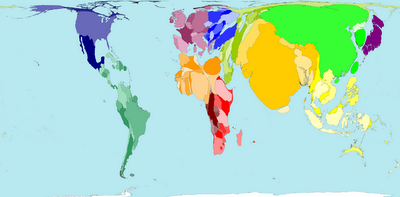
And now, a bit of future too.
11. Year 2050
"By 2050 it is estimated that the earth's human population will be 9.07 billion. 62% of the people will live in Africa, Southern Asia and Eastern Asia - numerically this is the same as if all the world's current population lived just in these regions. In addition another 3000 000 000 will be spread accross the rest of the world.
All numbers shown here are estimates - estimates are never perfect."
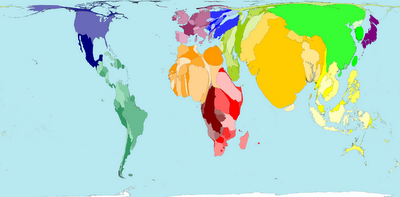
12. Year 2300
"By 2300 the United Nations forecasts that the global population will be just under 9 billion. World population is expected to rise, peak and then decline slightly between 2050 and 2300. The highest long term population growth is predicted for Africa. Africa is currently underpopulated and has the lowest life expectancies. Other regions' populations are predicted to stay level or decline. Between 2050 and 2300 the areas currently known as India, China, the United States and Pakistan maintain their ranked order as having the world's highest populations. The numbers shown here are estimates - based on predicted future behaviours."

I hope that was an interesting and educating experience because it sure was for me.
All maps and quoted text from World Mapper
*for more information on cartograms and how to generate them visit Cartograms from Physics
Just for fun, here's my clumsy attempt at drawing the world map:
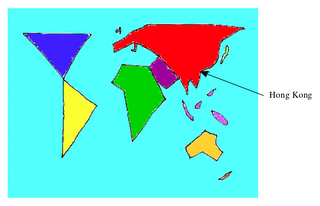
But more importantly, the map shows the vague location of Hong Kong, for those who doesn't know where it is.

It's the famous Peters projection - the Area map. Okay let's give it credit for giving us a general idea of the spatial structure of the land mass on Earth, but the maps below will blow your mind.
1. Upside down

This is easy to obtain - I've done this myself - just rotate the original map by 180º. But it does change the way you view the world.
You may say boring... now what? How about using an algorithm now, to blow up the map according to:
2. Total children

3. Total elderly

4. Tourist destinations

5. Tourist origins

These are density-equalising maps, known as cartograms. Once you've got the data, say from World Bank, you can use an algorithm (once used for linear diffusion from elementary physics*) to allow 'population to flow out from high-density to low-density areas'.
As promised, a bit of history now. But using cartograms to make this more entertaining.
Blown-up maps of population in:
6. Year 1
"The population two thousand years ago is estimated to have been 231 million. At this time North and South America were sparsely populated, as was Asia Pacific. The estimated population of New Zealand was zero. Southern Asia, Northern Africa, China and Southern Europe (parts of the same land mass) had relatively high populations. Colder Northern latitudes tended to have lower populations.
The territories that now encompass the Ganges, Tigris, Yangtze, Nile and Po rivers were the most populous."

7. Year 1500
"At the time of Spanish conquest in South America, and when Christopher Columbus was exploring Central and South America, the combined population of Mexico and Peru was greater than the total of all other American countries.
The regions with the largest populations remained Southern Asia and Eastern Asia. Together these contained more than half of the world's population.
Worldwide population distribution in 1500 was roughly similar to that in year 1, despite the numbers almost doubling over this period."

8. Year 1900
"The world population tripled between 1500 and 1900, to an estimated 1564 million. In that period, the populations of the United Kingdom and the United States increased more than ten-fold, the population of the Netherlands increased five-fold. For most of this time the Netherlands were known as the United Provinces; whilst neither the United Kingdom, nor the United States, had been formed.
In 1900 much of the world was under imperial rule, new territorial boundaries were being defined and contested. The borders of Africa shown in this map were mostly drawn at the Treaty of Versaille, in 1919."

9. Year 1960
"The world population in 1960 was 3,039 million. As is the case today, the populations of China and India are (independently) more than twice as big as that of the next largest territory.
South America has increased its proportion of the world's population living there, since 1900. The Western European proportion of the world population began to decline in 1900 when it was 15%, to 11% in 1960 and then 6% in 2000."

10. Now... close enough: Year 2000
"In Spring 2000 world population estimates reached 6 billion; that is 6 thousand million. The distribution of the earth's population is shown in this map.
India, China and Japan appear large on the map because they have large populations. Panama, Namibia and Guinea-Bissau have small populations so are barely visible on the map.
Population is very weakly related to land area. However, Sudan which is geographically the largest country in Africa, has a smaller population than Nigeria, Egypt, Ethiopia, Democratic Republic of Congo, South Africa and Tanzania."

And now, a bit of future too.
11. Year 2050
"By 2050 it is estimated that the earth's human population will be 9.07 billion. 62% of the people will live in Africa, Southern Asia and Eastern Asia - numerically this is the same as if all the world's current population lived just in these regions. In addition another 3000 000 000 will be spread accross the rest of the world.
All numbers shown here are estimates - estimates are never perfect."

12. Year 2300
"By 2300 the United Nations forecasts that the global population will be just under 9 billion. World population is expected to rise, peak and then decline slightly between 2050 and 2300. The highest long term population growth is predicted for Africa. Africa is currently underpopulated and has the lowest life expectancies. Other regions' populations are predicted to stay level or decline. Between 2050 and 2300 the areas currently known as India, China, the United States and Pakistan maintain their ranked order as having the world's highest populations. The numbers shown here are estimates - based on predicted future behaviours."

I hope that was an interesting and educating experience because it sure was for me.
All maps and quoted text from World Mapper
*for more information on cartograms and how to generate them visit Cartograms from Physics
Just for fun, here's my clumsy attempt at drawing the world map:

But more importantly, the map shows the vague location of Hong Kong, for those who doesn't know where it is.
Tuesday, May 09, 2006
Did you know? #3
"Dear Dr Hypothesis,
Over Christmas I decided to avoid my annoying family, and spent the whole two weeks watching films in my room. Several of these films contained scenes of beheading. The time it took the beheaded person to die seemed to vary considerably, depending on the ego of the actor involved. Could you please tell me how long it actually takes a human to die, following decapitation?
Headless Henry
Dr Hypothesis says:
It’s not really known exactly how long it takes brain activity to cease following beheading, because – to my knowledge – no scientifically controlled experiments have been carried out. Anecdotal evidence from executions during the French Revolution suggests that a head could respond up to thirty seconds after being removed from the body. However, this is nothing compared to cockroaches: they are known to survive for up to a week after beheading, ultimately dying from dehydration as they obviously have no way of drinking!"
From BlueSci Magazine
I hate cockroaches! I don't know why anyone would behead them... but I'd flush them in the toilet and hope they would die from overhydration.
Next post: Cartograms - a bit of geography, history, and creativity
Over Christmas I decided to avoid my annoying family, and spent the whole two weeks watching films in my room. Several of these films contained scenes of beheading. The time it took the beheaded person to die seemed to vary considerably, depending on the ego of the actor involved. Could you please tell me how long it actually takes a human to die, following decapitation?
Headless Henry
Dr Hypothesis says:
It’s not really known exactly how long it takes brain activity to cease following beheading, because – to my knowledge – no scientifically controlled experiments have been carried out. Anecdotal evidence from executions during the French Revolution suggests that a head could respond up to thirty seconds after being removed from the body. However, this is nothing compared to cockroaches: they are known to survive for up to a week after beheading, ultimately dying from dehydration as they obviously have no way of drinking!"
From BlueSci Magazine
I hate cockroaches! I don't know why anyone would behead them... but I'd flush them in the toilet and hope they would die from overhydration.
Next post: Cartograms - a bit of geography, history, and creativity
Please help: Tile frenzy
I really want to add background tiles on this blog to make it more personal. I collected some tiles but I do not know what to do with them now.





Can an experienced blogger teach me how to add tiles to the background of my blog, preferably just the sides?
To avoid confusion, here's what I want my blog to look like:

I'm not an art nor IT person, so forgive me.
Website of the day: Citrusmoon





Can an experienced blogger teach me how to add tiles to the background of my blog, preferably just the sides?
To avoid confusion, here's what I want my blog to look like:

I'm not an art nor IT person, so forgive me.
Website of the day: Citrusmoon
Monday, May 08, 2006
Work experience #1
I just called the career's advisor, and he said BASF is accepting 2 to 3 students from our school to go work there for two weeks. To go or not to go?
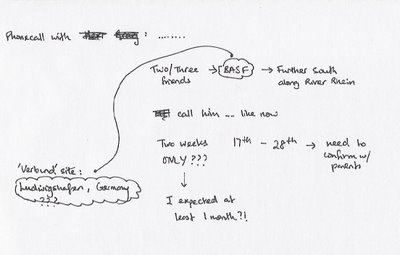
Go to basf.com for more information.
Actually, I will go there now to find more information about this corporation. I don't even know where it is?!
EDIT: I am going.

Can you work out what I am going to do?

Go to basf.com for more information.
Actually, I will go there now to find more information about this corporation. I don't even know where it is?!
EDIT: I am going.

Can you work out what I am going to do?
Did you know? #2
"Dear Dr Hypothesis, I am about to make a long distance trip, and, despite many worries that have recently been highlighted by the press, I am actually more concerned about the direction water will drain down my plughole when I cross the equator. Is it true that it flows in a different direction in the southern hemisphere, and if so, why? Plughole Paul
DR HYPOTHESIS SAYS: This is a widely held misconception, Paul, but it does have some basis in scientific theory. The Coriolis force, which is driven by the rotation of the Earth, can drive fluids to flow anticlockwise in the northern hemisphere and clockwise in the southern hemisphere. However, this force is very weak and so, on the scale of a sink or a bath, is almost always overcome by more important factors such as the temperature of the water or previous currents in the water. It should, in principle, be possible by to make water flow clockwise, anticlockwise and even straight down the same plughole by simply altering other variables such as those mentioned above."
From BlueSci Magazine
But wait?! I remember I was really convinced of this Coriolis force when I went to Kenya on the equator. Our guide had a bucket of water and a large funnel on top of it. We used a floating piece of plastic to show the direction of water flow. We started from the north hemisphere, then the equator, then the south hemisphere. The water did drain the opposite direction when we passed the equator to the other side of Earth. I also remember the water drained vertically when we were directly on the equator!
Here's some evidence I experienced this (October 2004):
1. Equator

2. Northern hemisphere
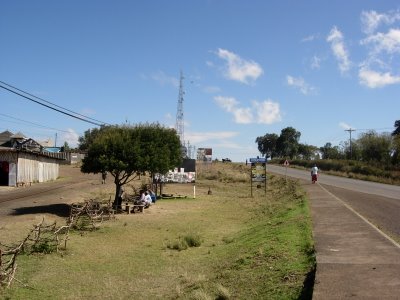
3. Southern hemisphere
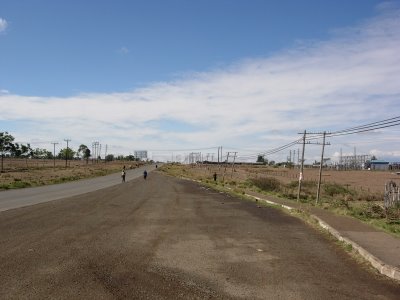
DR HYPOTHESIS SAYS: This is a widely held misconception, Paul, but it does have some basis in scientific theory. The Coriolis force, which is driven by the rotation of the Earth, can drive fluids to flow anticlockwise in the northern hemisphere and clockwise in the southern hemisphere. However, this force is very weak and so, on the scale of a sink or a bath, is almost always overcome by more important factors such as the temperature of the water or previous currents in the water. It should, in principle, be possible by to make water flow clockwise, anticlockwise and even straight down the same plughole by simply altering other variables such as those mentioned above."
From BlueSci Magazine
But wait?! I remember I was really convinced of this Coriolis force when I went to Kenya on the equator. Our guide had a bucket of water and a large funnel on top of it. We used a floating piece of plastic to show the direction of water flow. We started from the north hemisphere, then the equator, then the south hemisphere. The water did drain the opposite direction when we passed the equator to the other side of Earth. I also remember the water drained vertically when we were directly on the equator!
Here's some evidence I experienced this (October 2004):
1. Equator

2. Northern hemisphere

3. Southern hemisphere

Did you know? #1
Did you know that ice has a tetrahedral structure like diamond, but instead of covalent bonds, hydrogen bonds are responsible for the open-spaced structure. This explains why ice is less dense than liquid water. Water is one of a few substances in which the solid state is less dense than the liquid state.

Other substances that have this property include:
- silicon
- and other metalloid elements
Are there anymore? Scientists help!
EDIT: In fact, there are fourteen known solid phases of water, and the one I just described to you is known as Ice Ic.

For more information go to Wikipedia: Ice

Other substances that have this property include:
- silicon
- and other metalloid elements
Are there anymore? Scientists help!
EDIT: In fact, there are fourteen known solid phases of water, and the one I just described to you is known as Ice Ic.

For more information go to Wikipedia: Ice
Lesson #2: Good organisation is important
My mind is still blurry, so I need some direction now. My priority right now is, without any doubt, exams. So let me sort out my priorities among my many exams.
From early to late:
1. Geography
2. Statistics
3. Biology
4. Mechanics
5. Chemistry
6. Physics
7. Pure Mathematics
From shaky to confident:
1. Geography
2. Biology
3. Physics
4. Mechanics
5. Chemistry
6. Pure Mathematics
7. Statistics
Conclusion: Geography and Biology! Definitely revising this week.
My schedule:
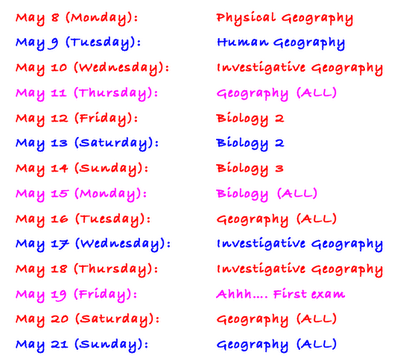
Song of the day: "Fragile Heart" by Jewel in both albums "0304" and "Goodbye Alice In Wonderland"
From early to late:
1. Geography
2. Statistics
3. Biology
4. Mechanics
5. Chemistry
6. Physics
7. Pure Mathematics
From shaky to confident:
1. Geography
2. Biology
3. Physics
4. Mechanics
5. Chemistry
6. Pure Mathematics
7. Statistics
Conclusion: Geography and Biology! Definitely revising this week.
My schedule:

Song of the day: "Fragile Heart" by Jewel in both albums "0304" and "Goodbye Alice In Wonderland"
Sunday, May 07, 2006
Lesson #1: Forgiveness is power
I have just learnt that forgiveness is a kind of power.
Some people can hate you a lot, maybe even for no reason, but you have the power to forgive them. You forgive them.
Wow, I feel so much better now.
I forgive.

But if someone else is on the receiving end and they do not forgive you, you cannot force them to. Ask forgiveness again, and if that doesn't work, you just have to rely on yourself to forgive that someone.
Some people can hate you a lot, maybe even for no reason, but you have the power to forgive them. You forgive them.
Wow, I feel so much better now.
I forgive.

But if someone else is on the receiving end and they do not forgive you, you cannot force them to. Ask forgiveness again, and if that doesn't work, you just have to rely on yourself to forgive that someone.
Just got in the mood...
I'm just a 16 year old student struggling with life...
Today is supposed to be a very busy day, but I haven't started doing anything yet. In actual fact, this month and the following month would become my busiest months of the year.
But everything is happening at the same time.
My brain cannot focus on everything, so I have decided to write everything down on this blog.
1. Exam pressure: I have to start revising. Not that I haven't started, but I just feel I haven't done enough. I promise myself that after I finish this post, I will get on with revising immediately.
My geography notes:

2. Bullying: When I was younger, I was bullied by classmates. Now I am bullied by a teacher. I have decided to end all this tomorrow by seeing the headmaster. I am so nervous?! Will talk about this more in detail later...
EDIT: I cancelled the appointment. I decided to forgive him, everyone.

3. JAGBC: I'm in this global business challenge organised by Junior Achievement, where you enter decisions such as marketing, price, production of a particular product and earn virtual money. You get a final score called MPI at the end of each round, and basically if you are the top two in your group, you get to advance; there are three rounds and a final round. We are currently in the second round, and everything so far is done online. If we win the third round, we get to go to Palo Alto in the US to compete in the final round!! How amazing is that? But considering only 8 teams are chosen, we'd have to be very lucky...
One of our reports:

4. Work experience: I applied for work experience in a foreign country via my school (for Summer 2006) but haven't gotten a reply yet. I am hanging on a string right now. Should I book the flight ticket or not?
5. Secrets: There are so many things I am keeping inside myself. I wish I could spurt it all out, but it's not as easy as it seems. I may post some of my deep secrets soon when my life is less hectic and busy. But now I will just have to learn how to balance my priorities.
Pic of the day: Mutated leaf on my notes
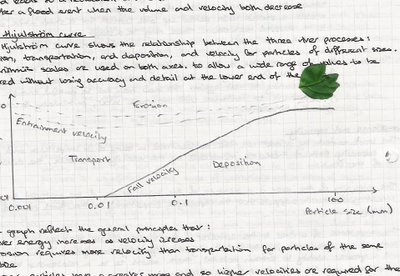
Next posts:
- a day with the headmaster
- previous work experience
- my school days
- my general interests (blogs, websites, music, podcasts, sports...)
- my subject interests (chemistry, maths, physics, nerdy stuff...)
*****
EXTRA NOTES:
- click on the pictures to expand them; reload page if necessary
- do not expect much posting the following few months due to exam period
- please feel free to comment, but I'm not sure how you got here in the first place :)
Today is supposed to be a very busy day, but I haven't started doing anything yet. In actual fact, this month and the following month would become my busiest months of the year.
But everything is happening at the same time.
My brain cannot focus on everything, so I have decided to write everything down on this blog.
1. Exam pressure: I have to start revising. Not that I haven't started, but I just feel I haven't done enough. I promise myself that after I finish this post, I will get on with revising immediately.
My geography notes:

2. Bullying: When I was younger, I was bullied by classmates. Now I am bullied by a teacher. I have decided to end all this tomorrow by seeing the headmaster. I am so nervous?! Will talk about this more in detail later...
EDIT: I cancelled the appointment. I decided to forgive him, everyone.

3. JAGBC: I'm in this global business challenge organised by Junior Achievement, where you enter decisions such as marketing, price, production of a particular product and earn virtual money. You get a final score called MPI at the end of each round, and basically if you are the top two in your group, you get to advance; there are three rounds and a final round. We are currently in the second round, and everything so far is done online. If we win the third round, we get to go to Palo Alto in the US to compete in the final round!! How amazing is that? But considering only 8 teams are chosen, we'd have to be very lucky...
One of our reports:

4. Work experience: I applied for work experience in a foreign country via my school (for Summer 2006) but haven't gotten a reply yet. I am hanging on a string right now. Should I book the flight ticket or not?
5. Secrets: There are so many things I am keeping inside myself. I wish I could spurt it all out, but it's not as easy as it seems. I may post some of my deep secrets soon when my life is less hectic and busy. But now I will just have to learn how to balance my priorities.
Pic of the day: Mutated leaf on my notes

Next posts:
- previous work experience
- my school days
- my general interests (blogs, websites, music, podcasts, sports...)
- my subject interests (chemistry, maths, physics, nerdy stuff...)
*****
EXTRA NOTES:
- click on the pictures to expand them; reload page if necessary
- do not expect much posting the following few months due to exam period
- please feel free to comment, but I'm not sure how you got here in the first place :)


